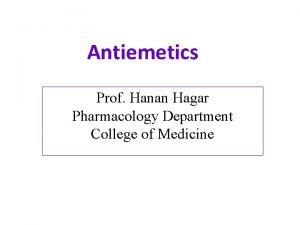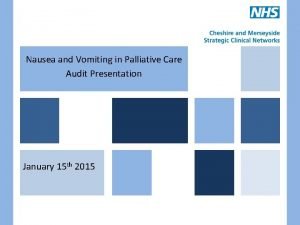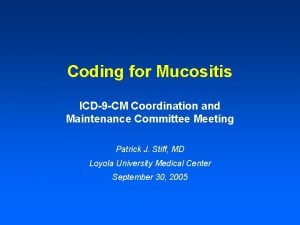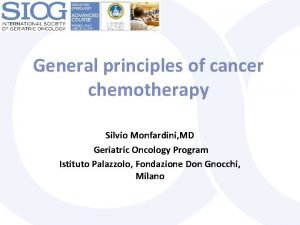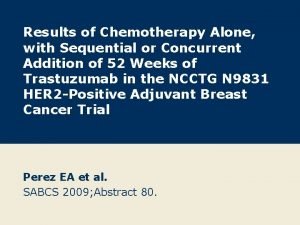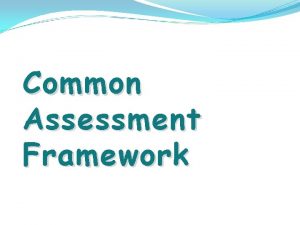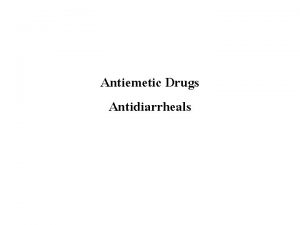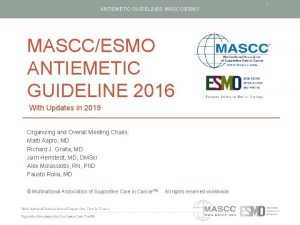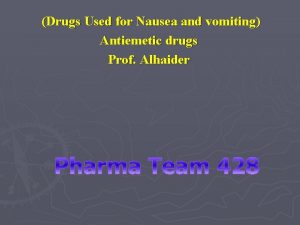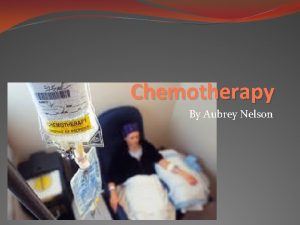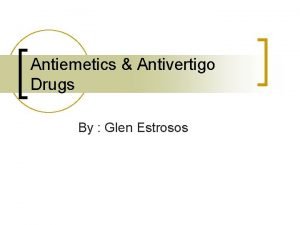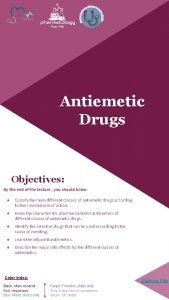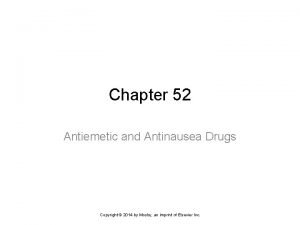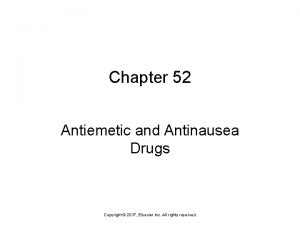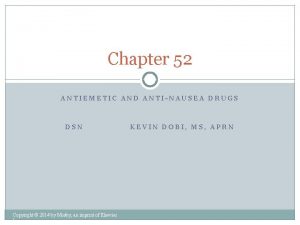Antiemetic Drugs Drugs Used to Control Chemotherapy Induced









![4. Butyrophenones: Droperidol [droe-PER-i-doll] and haloperidol [hal-oh- PER-i-doll] act by blocking dopamine receptors. • 4. Butyrophenones: Droperidol [droe-PER-i-doll] and haloperidol [hal-oh- PER-i-doll] act by blocking dopamine receptors. •](https://slidetodoc.com/presentation_image_h/0984a94c000084e3b8958ca8f6c18b0c/image-10.jpg)
![5. Benzodiazepines: The antiemetic potency of lorazepam [lor-Aze- pam] and alprazolam [al-PRAH-zoe-lam] is low. 5. Benzodiazepines: The antiemetic potency of lorazepam [lor-Aze- pam] and alprazolam [al-PRAH-zoe-lam] is low.](https://slidetodoc.com/presentation_image_h/0984a94c000084e3b8958ca8f6c18b0c/image-11.jpg)
![7. Substance P/neurokinin-1 receptor blocker: Aprepitant [ah-PRE-pih-tant] targets the neurokinin receptor in the brain 7. Substance P/neurokinin-1 receptor blocker: Aprepitant [ah-PRE-pih-tant] targets the neurokinin receptor in the brain](https://slidetodoc.com/presentation_image_h/0984a94c000084e3b8958ca8f6c18b0c/image-12.jpg)

- Slides: 13

Antiemetic Drugs

Drugs Used to Control Chemotherapy Induced Nausea and Vomiting • Although nausea and vomiting occur in a variety of conditions (for example, motion sickness, pregnancy, and hepatitis) and are always unpleasant for the patient. • The nausea and vomiting produced by chemotherapeutic agents demands especially effective management. • Nearly 70% to 80% of patients who undergo chemotherapy experience nausea and/or vomiting. • Several factors influence the incidence and severity of chemotherapy-induced nausea and vomiting (CINV), including the specific chemotherapeutic drug; the dose, route, and schedule of administration; and patient variables. • For example, young patients and women are more susceptible than older patients and men, and 10% to 40% of patients experience nausea and/or vomiting in anticipation of chemotherapy (anticipatory vomiting). CINV not only affects quality of life but can also lead to rejection of potentially curative chemotherapy. In addition, uncontrolled vomiting can produce dehydration, profound metabolic imbalances, and nutrient depletion.

Comparison of Emetic Potential of Anticancer Drugs

A. Mechanisms That Trigger Vomiting v. Two brainstem sites have key roles in the vomiting reflex pathway. • Chemoreceptor Trigger Zone (CTZ). It is outside the blood–brain barrier. • Thus, it can respond directly to chemical stimuli in the blood or cerebrospinal fluid. • Vomiting Center coordinates the motor mechanisms of vomiting. The vomiting center also responds to afferent input from the vestibular system, the periphery (pharynx and GI tract), and higher brainstem and cortical structures. ü The vestibular system functions mainly in motion sickness.

B. Emetic actions of chemotherapeutic agents • Chemotherapeutic agents can directly activate the medullary CTZ or vomiting center. • Several neuroreceptors, including dopamine receptor type 2 and serotonin type 3 (5 -HT 3), play critical roles. • Often, the color or smell of chemotherapeutic drugs (and even stimuli associated with chemotherapy) can activate higher brain centers and trigger emesis. • Chemotherapeutic drugs can also act peripherally by causing cell damage in the GI tract and by releasing serotonin from the enterochromaffin cells of the small intestine. • Serotonin activates 5 -HT 3 receptors on vagal and splanchnic afferent fibers, which then carry sensory signals to the medulla, leading to the emetic response.

C. Antiemetic drugs • Considering the complexity of the mechanisms involved in emesis, it is not surprising that antiemetics represent a variety of classes and offer a range of efficacies’. • Anticholinergic drugs, especially the muscarinic receptor antagonist scopolamine • H 1 -receptor antagonists, such as dimenhydrinate, meclizine, and cyclizine, are very useful in motion sickness but are ineffective against substances that act directly on the CTZ.

q The major categories of drugs used to control CINV include the following: Ø 1. Phenothiazines: The first group of drugs shown to be effective antiemetic agents, phenothiazines, such as prochlorperazine [proe-klor-PER-ah-zeen], act by blocking dopamine receptors. • Prochlorperazine is effective against low or moderately emetogenic chemotherapeutic agents (for example, fluorouracil and doxorubicin). Although increasing the dose improves antiemetic activity, side effects are dose limiting. Ø 2. 5 -HT 3 receptor blockers: The 5 -HT 3 receptor antagonists • Ondansetron [on-DAN-seh-tron], Granisetron [gra-NI-sehtron], • Palonosetron [pa-low-NO-seh-tron], and Dolasetron [dol-Aseh-tron]. • These agents selectively block 5 -HT 3 receptors in the periphery (visceral vagal afferent fibers) and in the brain (CTZ).

• This class of agents is important in treating emesis linked with chemotherapy, largely because of their longer duration of action and superior efficacy. • These drugs can be administered as a single dose prior to chemotherapy (intravenously or orally) and are efficacious against all grades of emetogenic therapy. • Ondansetron and granisetron prevent emesis in 50% to 60% of cisplatin-treated patients. • These agents are also useful in the management of postoperative nausea and vomiting. • 5 -HT 3 antagonists are extensively metabolized by the liver; however, only ondansetron requires dosage adjustments in hepatic insufficiency. ü Elimination is through the urine. Electrocardiographic changes, such as a prolonged QTc interval, can occur with dolasetron and high doses of ondansetron. • For this reason, dolasetron is no longer approved for CINV prophylaxis.

• 3. Substituted benzamides: One of several substituted benzamides with antiemetic activity, metoclopramide [met-oh-kloe-PRAH-mide] is effective at high doses against the emetogenic cisplatin, preventing emesis in 30% to 40% of patients and reducing emesis in the majority of patients. • Metoclopramide accomplishes this through inhibition of dopamine in the CTZ. ü Antidopaminergic side effects, including extrapyramidal symptoms, limit long-term high-dose use. • Metoclopramide was previously used for the treatment of GERD. However, due to the adverse effect profile and the availability of more effective drugs, such as PPIs, it should be reserved for patients with documented gastroparesis.
![4 Butyrophenones Droperidol droePERidoll and haloperidol haloh PERidoll act by blocking dopamine receptors 4. Butyrophenones: Droperidol [droe-PER-i-doll] and haloperidol [hal-oh- PER-i-doll] act by blocking dopamine receptors. •](https://slidetodoc.com/presentation_image_h/0984a94c000084e3b8958ca8f6c18b0c/image-10.jpg)
4. Butyrophenones: Droperidol [droe-PER-i-doll] and haloperidol [hal-oh- PER-i-doll] act by blocking dopamine receptors. • The butyrophenones are moderately effective antiemetics. Droperidol had been used most often for sedation in endoscopy and surgery, usually in combination with opioids or benzodiazepines. • However, it may prolong the QTc interval and should be reserved for patients with inadequate response to other agents. High-dose haloperidol was found to be nearly as effective as high-dose metoclopramide in preventing cisplatin-induced emesis.
![5 Benzodiazepines The antiemetic potency of lorazepam lorAze pam and alprazolam alPRAHzoelam is low 5. Benzodiazepines: The antiemetic potency of lorazepam [lor-Aze- pam] and alprazolam [al-PRAH-zoe-lam] is low.](https://slidetodoc.com/presentation_image_h/0984a94c000084e3b8958ca8f6c18b0c/image-11.jpg)
5. Benzodiazepines: The antiemetic potency of lorazepam [lor-Aze- pam] and alprazolam [al-PRAH-zoe-lam] is low. • Their beneficial effects may be due to their sedative, anxiolytic, and amnesic properties. These same properties make benzodiazepines useful in treating anticipatory vomiting. • Concomitant use of alcohol should be avoided due to additive CNS depressant effects. 6. Corticosteroids: Dexamethasone [dex-a-MEH-tha-sone] and methylprednisolone [meth-ill-pred-NIH-so-lone], used alone, are effective against mildly to moderately emetogenic chemotherapy. Most frequently, however, they are used in combination with other agents. üTheir antiemetic mechanism is not known, but it may involve blockade of prostaglandins.
![7 Substance Pneurokinin1 receptor blocker Aprepitant ahPREpihtant targets the neurokinin receptor in the brain 7. Substance P/neurokinin-1 receptor blocker: Aprepitant [ah-PRE-pih-tant] targets the neurokinin receptor in the brain](https://slidetodoc.com/presentation_image_h/0984a94c000084e3b8958ca8f6c18b0c/image-12.jpg)
7. Substance P/neurokinin-1 receptor blocker: Aprepitant [ah-PRE-pih-tant] targets the neurokinin receptor in the brain and blocks the actions of the natural substance. • Aprepitant is indicated only for highly or moderately emetogenic chemotherapy regimens. • It is usually administered orally with dexamethasone and a 5 -HT 3 antagonist. It undergoes extensive metabolism, primarily by CYP 3 A 4, and it may affect the metabolism of other drugs that are metabolized by this enzyme, such as warfarin and oral contraceptives.

8. Combination Regimens: ü Antiemetic drugs are often combined to increase antiemetic activity or decrease toxicity. ü Corticosteroids, most commonly dexamethasone, increase antiemetic activity when given with highdose metoclopramide, a 5 -HT 3 antagonist, phenothiazine, butyrophenone, or a benzodiazepine. Ø Antihistamines, such as diphenhydramine, are often administered in combination with high-dose metoclopramide to reduce extrapyramidal reactions or with corticosteroids to counter metoclopramide induced diarrhea.
 Classification of antiemetic drugs
Classification of antiemetic drugs Seamus hesney
Seamus hesney Induced dipole induced dipole attraction
Induced dipole induced dipole attraction Reglan mechanism of action
Reglan mechanism of action Bsa calculation formula for chemotherapy
Bsa calculation formula for chemotherapy Chemotherapy coding cheat sheet
Chemotherapy coding cheat sheet Principles of chemotherapy
Principles of chemotherapy General principles of chemotherapy
General principles of chemotherapy Chemotherapy
Chemotherapy Chemotherapy
Chemotherapy Common assesment framework
Common assesment framework 4ac 4t chemotherapy
4ac 4t chemotherapy Ppiucd tray
Ppiucd tray Teratogens images
Teratogens images
